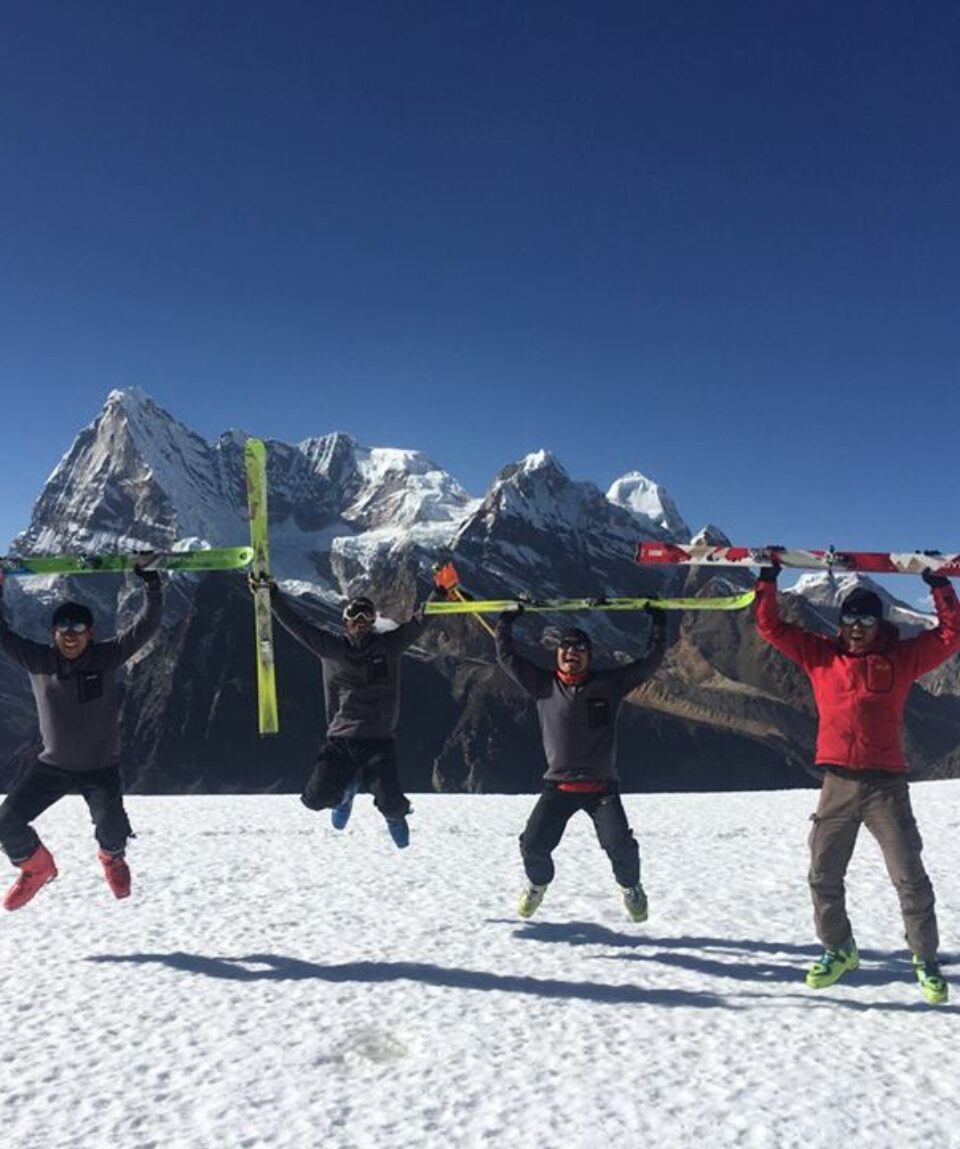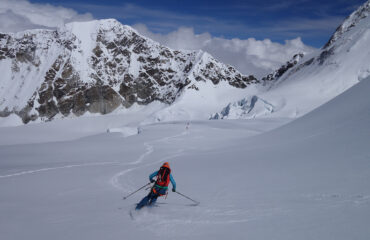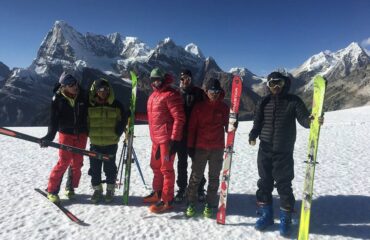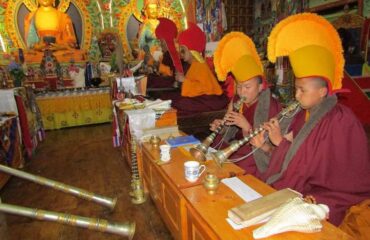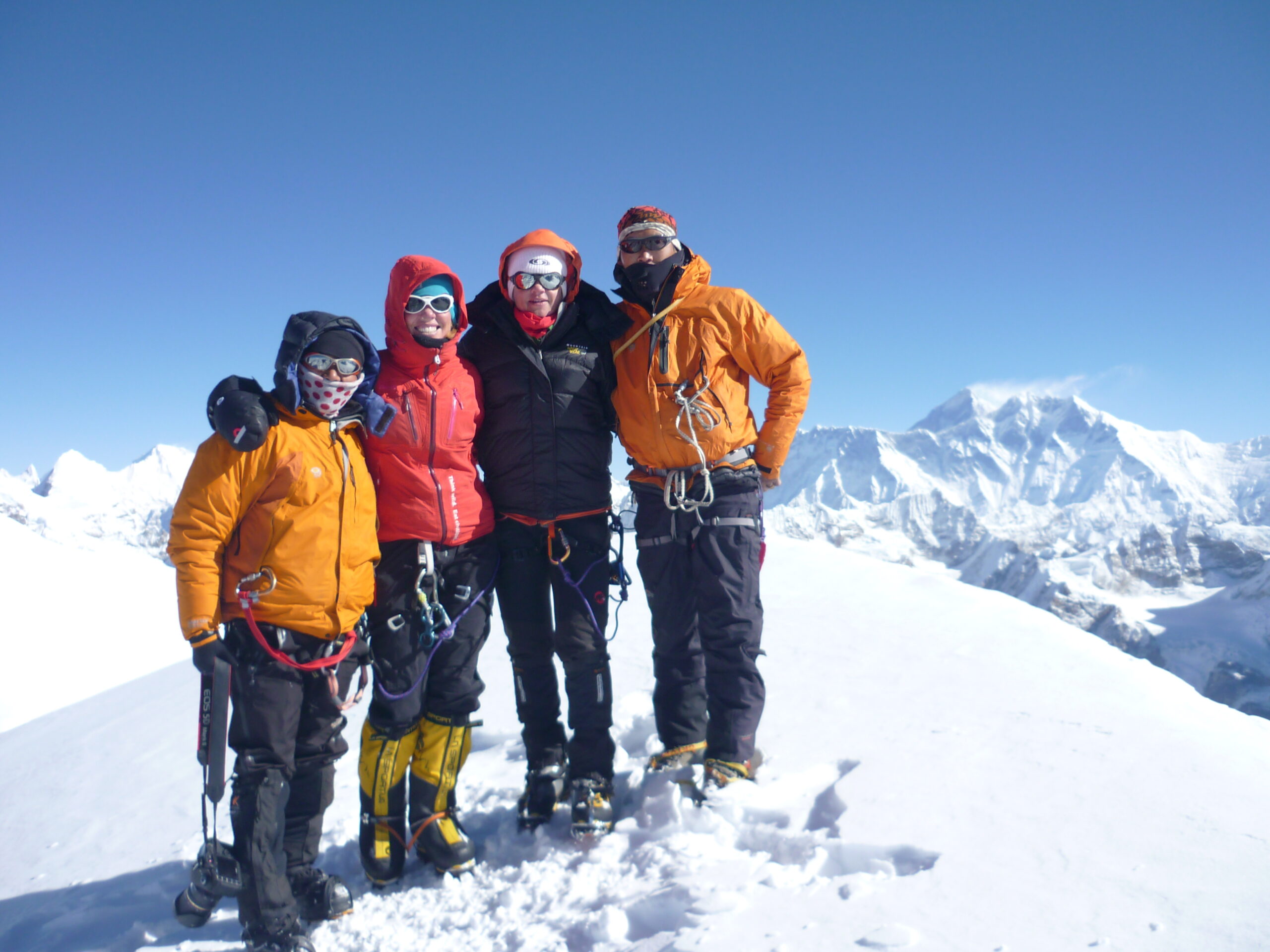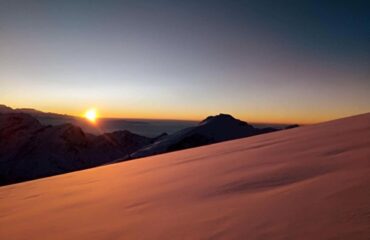Mera Peak Ski Expedition
fromExperience the Himalayas on skis, the ultimate way to experience this mountain range that includes high altitude trekking, mountain peak climbing, and skiing at one go
-
Reviews 0 Reviews0/5
-
Vacation Style Holiday Type
-
Hiking
-
Mountain
-
-
Activity Level Extreme
-
Group Size Medium Group
Ski-in Mera Peak is the uttermost Himalayan skiing adventure. This is a challenging high-altitude trek combined with an introductory mountaineering experience. Skiing in Mera Peak is one of the best ways to get thrilling experiences. Skiing in the Himalayan might be a dream for every adventurous Skier. It is high altitude trek combined with skiing, mountaineering, and trekking. Nepal’s highest trekking peak lies on the edge of the famous Khumbu Region, from where it unfolds the most exceptional panoramic views of five 8000 meter mountains including Mount Everest. Although Mera Peak is very high, the climbing is straightforward. This trip is ideal for those with moderate mountaineering experience, a good level of fitness, and a keen sense of adventure. Summit of Mera Peak on foot and descent by downhill skiing is only one best way to get high altitude ski-mountaineering experiences in the Himalayan. Mera Peak is all year suitable for ski-Mountaineering in Nepal.
Flexible Itineraries
There are several different routes to reach Mera Peak and the ending point within the lower Khumbu area that engages getting to Mera Peak. The Mera peak itinerary depends on a number of factors including mode of transportation, the route you take, and your time availability.
The usual durations (starting and ending in Kathmandu) are from 19 to 24 days depending on how long you’re planning for; we can craft a good tailored made trip based on how much time you have.
- Airport transfers and escort in Kathmandu
- All meals while on the trek (breakfast, lunch, dinner, hot beverage )
- Accommodation during the trek at the local lodge.
- Domestic airfares Kathmandu-Lukla-Kathmandu
- English speaking government-licensed Sherpa guide
- Climbing Sherpa & guide for climbing and mera peak ski
- Tents and equipment for base camp and high camp with full board service
- All the necessary trekking, climbing and ski permits
- National park and rural municipality entry fees
- Porter Service as required
- Staff cost including their (Salary, allowance, food, accommodation, summit bonus, and insurance )
- 3 nights accommodation at 3-star category hotel in Kathmandu on twin sharing basis with breakfast.
- All guided sightseeing tours in Kathmandu and entry fees.
- All ground transportation on comfortable private vehicle
- Certificate from Nepal Mountaineering Association after the successful summit
- All government and local taxes
- International airfare, departure Tax, and visa fees
- Trekking and climbing equipment
- Major meals, Lunch, and dinner during your stay in Kathmandu
- Any type of personal expenses, such as alcoholic beverages drinks, phone charges, and laundry.
- Rescue & travel insurance, trip cancellation costs, accident or health emergency, evacuation, loss, theft or damage to baggage, and personal effects.
- Tips & Gratuities to porters and guides
- We strongly advise you to take out personal travel insurance.
- Day 1 Depart Home Country
- Day 2 En Route (Transit)
- Day 3 Arrive in Kathmandu [1300 m/4264 ft]
- Day 4 Casual day and trip preparation
- Day 5 Drive to Phaplu [2413m/7916ft] 9-10 hrs
- Day 6 Drive to Kharikhola and Trek to Panggom [2850m/93,48ft]: 5-6 hrs
- Day 7 Panggom [2850m/93,48ft]:Rest and acclimatization day
- Day 8 Panggom to Ningsow (2,863m/9,394ft ) 4-5 hrs
- Day 9 Ningsow to Chhatra Khola (2,800m/9,187ft) 7-8 hrs
- Day 10 Chhatra Khola to Kothe (3,691m/12,110ft) 6-7 hrs
- Day 11 Kothe to Thaknak (4,358m/14,299ft ) 3-4 hrs
- Day 12 Acclimatization day
- Day 13 Thaknak to Khare (5,045m/16,553ft) 2-3 hrs
- Day 14 Khare: Acclimatization and pre climb training (5,045m/16,553ft)
- Day 15 Move to Mera High Camp (5,780m/18,964ft) 5-6 hrs
- Day 16 Mera High Camp to Summit [6,461m/21,1907ft] and back to Khare [5045m/16,547ft]: 8-9 hrs
- Day 17 Reserve day for Contingency
- Day 18 Khare to Kothe {3,691m/12,110ft} 4-5 hrs
- Day 19 Kothe to Thuli Kharka {4,300m/14,108ft} 5-6 hrs
- Day 20 Thuli Kharla to Lukla via Zatrwa La pass {4,600m/15,093ft} 6-7 hrs
- Day 21 Fly to kathmandu
- Day 22 Reserved day in kathmandu
- Day 23 Transfer to airport for final departure
- Day 24 En Route Home Country
- Day 25 Arrive Home Country
Having the right equipment on your adventure trips will make almost as much difference to your success, safety, comfort, and enjoyment as any physical training you do. It is essential that you take the time to acquire the correct gear; don’t wait for the last minute to find out your local shop doesn’t have your size. This equipment is expensive, but you can often find great sales online and at your local gear store. The purpose of this gear list is to help guide your purchases.
This list is a guide. While you are required to bring everything on this list, there are numerous options, brands, and versions of each piece of equipment, unless otherwise noted. Using our current suggested brand list we encourage you to shop around, do research, use your experience and the listed features to find the best gear for you.
During your time in the mountains, you will encounter a very wide range of temperatures and weather conditions. At one end of this range is the pleasantly warm and beautiful low land, while at the other end of the spectrum is found the cold and often windy weather of the highest peaks in the world. The equipment you bring must function well in a wide variety of conditions. Your clothing should be warm, lightweight, dry quickly, and allow good freedom of movement. The layering principle, based on several thin layers of insulation
(rather than one thick one), covered with an outer weatherproof shell, meets these needs well.
A Note on Packing
For your international flights, we recommend that you pack all your equipment in your two duffle bags. Do not simply pack your backpack (since the straps can be damaged by the baggage handling machines). It is important to lock these bags for their trip. Depending on the airport, you may be able to put your travel locks on after TSA has searched the bags. If not, Lock the bags with Zip Ties. If the TSA cuts off the zip-tie to search your bag, they will replace it. You will still need the travel locks to lock your bags in the hotel and during the expedition. Generally, you will take one duffel up to Base Camp, and leave one in the hotel in Kathmandu with your belongings for your time in the city. Your trek in duffel will only be accessible in the evenings (with items such as changes of clothing, sleeping bag), and your day pack will hold vitals such as water, layering, blister kit, and camera.
Important Notes:
- Don’t cut corners on the quality of gears
- Understand the function of each gear properly
- Acquire your gears well in advance
- Eliminate unnecessary luxuries
- Seasonal fluctuation will impact the requirement of gear
Tips:
- You can always rent gears if you are not willing to invest
- Check the sizes especially of boots before leaving for the mountain
- Wear summit socks while trying the boots
Clothing
- Thermal Base Layers – Tops and Bottoms
- Heavy Base Layers
- Trekking Pants
- Hard-shell pants
- Down Pant
- T-shirts – Short and long sleeve
- Mid Layer Top
- Insulated Jacket
- Hard-shell Jacket
- Down Jacket/Parka
Footwear
- Double insulated mountaineering boots for climbing
- Hiking boots (Full and waterproof) for approach
- lightweight shoes for camp and around town
- Gaiters
- Flip-flops
- Wool/Synthetic socks
- Liner socks
Handwear
- Liner gloves
- Mid-weight gloves
- Down mittens
Headwear
- Cap/Sun Hat
- Buff
- Balaclava
- Warm wool/Synthetic Hat
- Eye Wear (Full coverage around eyes and nose)
- Ski Goggles
Climbing Gears
- Helmet
- Ice Axe with a waist leash
- Mountaineering Crampons
- Lightweight Mountaineering Harness
- Carabiners (2 Screwgate and 2 Snapgate)
- Belay Device(ATC Guide or Figure 8)
- Ascender/Jumar
- Prussik /Accessory Cord
Backpacking
- Small pack (35-40 liters)
- Waterproof duffel bag
- Padlocks for the duffel bag
- Pack cover
Accessories
- Water Bottles: 2 bottles of 1 litre each with insulation cover
- Trekking poles
- Headlamp: 200-300 lumens with spare batteries
- Camera
- Power bank/Solar Charger
- Universal adapter
- Notebooks/Diary
- Pocket knife
Hygiene and first aid
- Skincare (Maximum SPF sunscreen and lip balm)
- Toothbrush, Toothpaste, Soap, Moisturizer
- Hand Sanitizer
- Toilet paper and wet wipes
- Personal first aid kit (Include personal prescriptions, high altitude medications, painkillers, first-aid tape, band-aids etc.)
- Water treatment
Others
- Comfort Foods (Bring snacks and foods you like to munch)
- Travel clothes to wear in Kathmandu
- Sleeping bag (-20 degrees sleeping bag)
- Inflatable mattress
Ski Packing List
There’s nothing worse than leaving your ski holiday packing to the last minute and drowning in a pile of gloves, socks and thermals the night before you leave. Take your time and go through our useful guide for snowsports essentials to help make sure you’ve got everything you need in your bag.
The golden rule of ski holiday preparation is clever packing. We’ve all been there… stuck at the top of a lift on the coldest day having left behind a crucial piece of clothing or kit. If you have a history of poor packing, we’ve created a fail-safe packing list to make sure you bring everything you need.
Travel Essentials
- Tickets, travel money, passport
- Flight/train/ferry/coach/transfer details
- Holiday/accommodation/ski hire details
- Insurance details
- Fully charged mobile phone, charger and external battery
Ski/Snowboard Equipment
- Ski boots/snowboard boots
- Skis/snowboard (in ski bag)
- Poles
- Day rucksack
- Helmet
- Transceiver, shovel and probe (for staying safe off piste)
- Water bottle or Camelbak
- Multitool for repairs or adjustments on the go
- Ski Goggles
Ski/Snowboard Clothing:
- Warm hat/beanie
- Sunglasses
- Neck warmer/buff
- 2x thermal tops
- 2x fleeces
- Waterproof ski jacket
- Waterproof ski trousers
- Waterproof gloves or mittens
- Thermal bottoms
- 2 or 3 pairs of ski/board socks
Other Clothes
- Jeans/long trousers
- T-shirts/tops
- Jumper or fleece
- Underwear including socks
- Comfy trousers/jogging bottoms
- Slippers
- Thin gloves
- Scarf
- Shoes/boots with a good grip
- Sports bra
Other Stuff:
- Pyjamas
- Toiletries including toothbrush
- Sunscreen – high SPF
- Lipsalve/balm with SPF
- Aftersun/moisturiser
- Snowchains if driving
- Swimming costume/trunks
- Camera and charger
- Travel plug adaptor
- Speakers and headphones
- Books
- Magazines
- High energy snacks – chocolate bars/energy bars/nuts
- Any medication (including painkillers)
- Alarm clock
- Ear plugs
Luxuries:
- Travel pillow
- GoPro
- Hairdryer
- Hair straighteners
- Cards/games
- Boot warmers
- Hand warmers
- Ankle/knee/wrist supports
- Deep Heat/muscle soaks
- Hip flask
- Handbag
Conclusion:
As the weather condition is unpredictable in the Himalayan region, you need to be prepared at all times. A day can start sunny with clear skies and later become cold and windy at the high altitudes.
Sometimes, it can rain and snow during the trekking period. You need to remember that for a successful trekking journey, your physical comfort must be the first priority.
Note:
Please note that these items listed above will vary according to the season, trek duration. Please remember that your luggage will be carried by the porter, but you need to carry a daypack on your own. We also suggest you pack only necessary items to keep the weight of your equipment to a minimum. Carrying a day pack only applies to the trekkers who take full package with us and those who take only guide they should bring the bag big enough to carry their own stuff. If you have any questions, please do not hesitate to contact us at your convenience.
We recommend climbing Mera Peak in late April, May, late September, October, and November. We find that when we climb on Mera Peak, generally the best months are May and October. If you decide to climb in late March, early April or late October into November, you need to be ready for colder conditions.
Climbing Mera peak itself is not very technical and doesn’t consist of a steep technical climb but the high altitude reaching 6461m at the summit makes this a challenging climb. Unlike other trekking peaks in Nepal, the climb to Mera peak is straightforward.
FITNESS
Climbers must be in excellent physical shape to join this expedition. This is perhaps the most important aspect of high altitude climbing, and cannot be stressed enough. Regular, challenging exercise for many months in advance of departure is the only way to gain the necessary level of fitness that is needed on big peaks. We highly recommend a structured training regime with a gym or personal trainer to assist you in preparing for climbing at altitude. Please contact us for more information on physical training.
TECHNICAL EXPERIENCE
Skiers must be competent on a variety of terrain and snow conditions. Skiers must be able to link turns in steep terrain (up to 45 degrees) while maintaining control. Skiers must also have basic snow climbing experience including use of ice axe and crampons.
ALTITUDE EXPERIENCE
It is required that climbers have prior experience at altitudes up to 14,000′ and it is strongly recommended that climbers have prior experience at altitudes over 15,000′
The time between October and December is the Nepal skiing season . During this time there’s a lot more snow on the ground post-monsoon than pre-monsoon.

